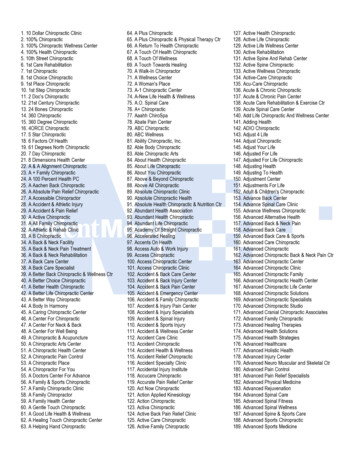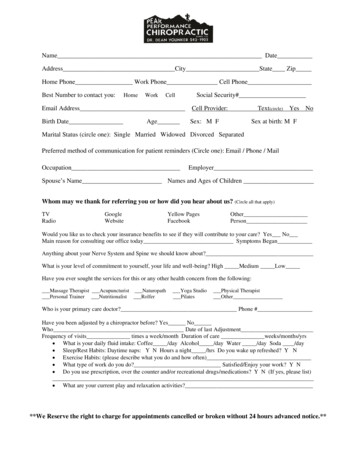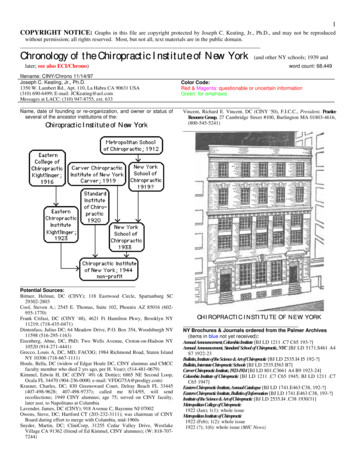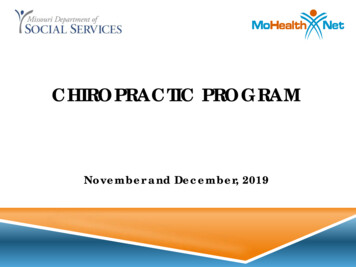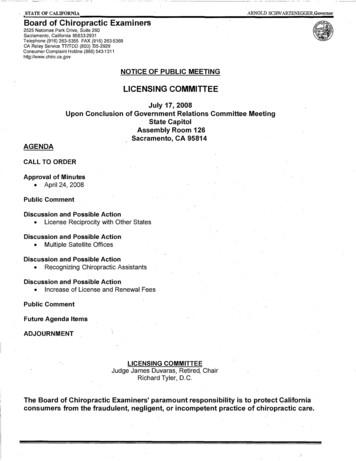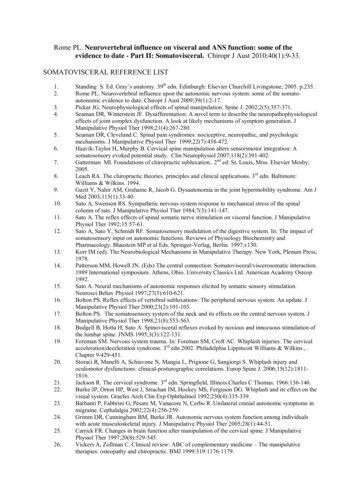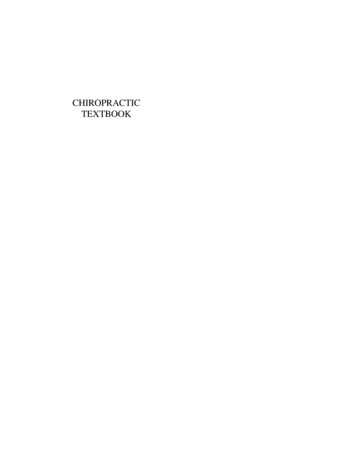
Transcription
CHIROPRACTICTEXTBOOK
R. W. STEPHENSON, D.C., Ph.C.
COPYRIGHT, 1927BYTHE PALMER SCHOOL of CHIROPRACTICPRINTED IN THE U.S.A.
DR. PALMER S LETTER OF APPROVAL OFCHIROPRACTIC TEXTBOOKDear “Stevie”:I could not blame you if you have grown impatient at myapparent silence in not giving you an expression of my opinionregarding your MSS. which you submitted for my approval ordisapproval.I have been doing some writing, taking my time to think it overcarefully; and, between times when tired, I would go over anotherchapter of your book.This is Sunday and I have just finished it. Of ALL the bookswritten and compiled on Chiropractic Philosophy, this is by far thebest, not excepting my own. The one great, grand and gloriousthing you HAVE done has been to compile the many principleswhich are in my writings, into a systematic, organized manner,building them up from simple to the higher forms, so that anylayman inclined could investigate and find out whatCHIROPRACTIC IS, IS NOT; WHAT IT DOES AND DOESNOT; HOW AND WHY IT DOES WHAT IT DOES. YOU haveclearly, carefully and consistently compiled the manyPRINCIPLES of Chiropractic into a readable, understandablebook, simple enuf for the layman, deep enuf for the savant.My writings are many. They are in one form or another; eitherhere or there. Each subject is exhaustive. If any person wanted fulland complete information on a specific subject, thenvii
LETTER OF APPROVALhe should go to the special monograph on that subject, but, if hewants the working approximate principle then in your book he getsthem all.Where has always been a void in Chiropractic literature.Assuming an understanding mind asks where he can get a bookwhich would tell him what Chiropractic is—I have always felt thatthere was no one specific work that we could hand him for thatpurpose. WE NOW HAVE THAT BOOK. It is your work. Youhave filled a niche that no other work has done. Here is a bookthat any chiropractor can hand to any investigating lay mind andknow that it will do him, Chiropractic and yourself justice. Yourwork can now be used as a handbook on that subject.I rejoice with you in its production.As ever,B. J.viii
PREFACETo GAIN knowledge of Chiropractic I came to the FountainHead. To me, then, the Fountain Head of Chiropractic was B. J. andnot the school. To me, B. J. is still the Fountain Head ofChiropractic. I look to him for unsullied Chiropractic. I feel that thefundamental principles of Chiropractic, as given by this greatteacher, are not to be tampered with by me or any one else, and inthis book I merely serve as “Transmission from Source toPeriphery.”I owe much to Dr. John H. Craven for more intimate instruction inChiropractic and its Philosophy. I knew he never deviated from theteachings of Dr. Palmer. I am thankful for the great lessons inPhilosophy and ideal Chiropractic and humanity, which I learnedfrom this sincere teacher.I have quoted freely from Dr. Palmer’s books, and from Dr. MabelPalmer and Dr. Craven; viz., Vol. V; Vol. IX; Vol. XV; Majors andMinors, (M&M).This book has been prepared for class room use. Accordingly it isdivided into sections for each semester. It has additional sections inetiology and thesis writing, for the convenience of the student. It ishoped that it will be a help to the field practitioner, who is still astudent of Chiropractic, offering to him a review, as well as the laterdevelopments in the science of Chiropractic. It was the intention ofthe writer to make this book more than a Philosophy; it is intendedto be a textbook of Chiropractic, conveying the more practical partsof Philosophy so that the student who pursues its subjects through,will have a comprehensive knowledge of Chiropractic. It is alsohoped that it will prove interesting to the layman, should he chooseto read it.The book, with the exception of the section on thesis writix
PREFACEing, is arranged in articles of varying lengths and numbered forreference and convenience. Each article is in two parts. Thestatements in bold faced type, contain the meat of the subject. Theyare the cardinal points—the high spots. If the student should learnthese only, he would have a good knowledge of the subject ofChiropractic. The balance of the article is elaboration of the same.The entire work is tied together by references, article to article,where it was deemed necessary; and proof given, by use of thefundamental principles, in the manner of deductive geometry.Bold faced type is used for more important statements, italics forterms, and words or names are emphasized by capitalization, wherenecessary. Especially is this true of words entirely Chiropractic incharacter.In the Introductory, Freshman, Sophomore, and Junior Section,are questions for review. These are intended to make the studentthink. Even if he is unable to answer some of them; if they set him tothinking; raise inquiry in the right direction, they have accomplishedtheir purpose. There are no questions in the Senior Section, for bythat time, the student should be able to ask his own question for thepurpose of reviews.Not until a student has reached the Senior Work is he able toquestion Chiropractic. The writer believes that no one is in aposition to question Chiropractic with any justice, until he hasstudied it. Spencer says, “There is a principle which is a bar againstinformation which is proof against all argument and which cannotfail to keep a man in everlasting ignorance. That principle iscondemnation before investigation.”RALPH W. STEPHENSON, D.C., Ph.C.x
LIST OF ILLUSTRATIONSPageFig. 1. The Safety Pin Cycle . 9Fig. 2. Triangle Cycle . 9Fig. 3. Quadrangle Cycle . 9Fig. 4. Universal Diagram . 10Fig. 5. The Normal Complete Cycle . 11Fig. 6. Relation of Universal Intelligence to InnateIntelligence . 13Fig. 7. Universal Diagram of Innate and Educated Bodies . 15Fig. 8. Nervous Tissue Cells (Central and Cyclic) . 27Fig. 9. Tissue Cells (Peripheral) . 34Fig. 10. Graph of Adaptations . 61Fig. 11. The Cycle of Sight . 71Fig. 12. Normal Complete and Special Sense, Compounded . 73Fig. 13. The Interbrain Cycle . 74Fig. 14. Abnormal Complete Cycle with Vertemere Cycle . 77Fig. 16. Abnormal Cycles . 84Fig. 16. Normal Complete Cycle, Applied . 86Fig. 17. The Restoration Cycle . 89Fig. 18. Cyclic Schemes of Local and Condition . 91Fig. 19. Momentum and Retracing Chart . 97Fig. 20. Analogy of The Water Pipe . 103xi
LIST OF ILLUSTRATIONSFig. 21. Scheme of The Serous Circulation . 106Fig. 22. Irrigated Field illustrating Wet and Dry Man . 109Fig. 23. Tissue Spaces, (Peripheral Scheme) . 113Fig. 24. Unsuccessful Poison Cycle . 151Fig. 25. Scheme of Zones . 167Fig. 26. Headache Charts . 174Fig. 27. General and Special sense scheme . 190Fig. 28. Graph, Minor Aggravated by a Major . 226Fig. 29. The Forest Giants. (Evolution Values) . 261Fig. 30. The Superficial Nervous System . 283Fig. 31. The Visceral Nervous System . 285Fig. 32. Peripheral Arrangements of Nerve Tissue . 287Fig. 33. The Cranial Nervous System . 289Fig. 34. Conduits and Communications . 291Fig. 35. Section of Spinal Cord . 291Fig. 36. Comparison of Electric Light Filament to AbnormalNeurone . 297Fig. 37. Cervical Cord Pressures, Cord Tensions andMultiple Pressures . 305Fig. 38. Sacral Cord Tension . 307Fig. 39. Rotated Subluxations . 319Fig. 40. Tilted Subluxations; Pedicle Positions . 321Fig. 41. Posterior Subluxations, Pedicle Positions, andIntervertebral Foramen . 323xii
INTRODUCTIONArt. 1. REMARKS.This book is written for use in the class room. It may, however, bestudied just as easily by the field practitioner, and is not tootechnical in most of its parts to be readily grasped by the layman. Ithas grown, rather than having been written; it is the expansion of thenotes which were tested in the class room for six years, and thewriter believes that, with the constant arrangement and betterment tosuit the requirements of the students of Chiropractic, this hascreated a real textbook, rendering easily understood a subject thatstudents have always said was difficult.Art. 2. CHIROPRACTIC DEFINED.“Chiropractic ifs a philosophy, science and art of thingsnatural; a system of adjusting the segments of the spinal columnby hand only, for the correction of the cause of dis-ease.”“Chiropractic is defined, the science of palpating and adjusting thearticulations of the human spinal column only.”“A system of adjustment consisting of palpation of the spinalcolumn to ascertain vertebral subluxations followed by theadjustment of them by hand, in order to relieve pressure upon nervesat the intervertebral foramina, so that the nerve force may flowfreely from the brain to the rest of the body.”The first definition is Dr. Palmer’s and is the best. It tells exactlywhat Chiropractic is, without limiting its scope and without sayingthings which are not true, as the others are inclined to do. Thesecond one is from the U.C.A. Model Bill, which is very limitingand therefore not exactly true. The third definition is from Dorland’sDictionary. After thexiii
INTRODUCTIONstudent has mastered this book, if not before, he will see that thisdefinition is too limited.Art. 3. SCIENCE, ART AND PHILOSOPHY.The definition of Chiropractic quoted in the foregoing, states thatit is a philosophy, science and art of things natural. Put simply, thatmeans, “what it is, how it is done, and why.” Science tells us what itis; art tells us how it is done, and philosophy, the “why” of the othertwo. According to that, then philosophy must tell us about bothscience and art; and that is the purpose of this book.Art. 4. SCIENCE.From Webster’s International Dictionary: “Accumulated andaccepted knowledge which has been systematized and formulatedwith reference to the discovery of general truths or the operation ofgeneral laws; knowledge classified and made available in work, life,or the search for truth; comprehensive, profound, or philosophicalknowledge. Any branch or department of systematizedknowledge considered as a distinct field of investigation orobject of study.” (Webster)Though Chiropractic is young, comparatively, it is none the less, awell developed science with proven facts and plausible theoriesbased upon those facts and precise art; all of them systematizedknowledge, and a distinct field of investigation or object of study.Art. 5. ART.“Skill, dexterity, or the power of performing certain actions,acquired by experience, study or observation; knack.”“Skill in adaptation of things in the natural world to the uses ofhuman life; human contrivance or ingenuity.”“The general principles of any branch of learning or of anydeveloped craft; a system of rules or organized modes ofxiv
INTRODUCTIONoperation serving to facilitate the performance of certain actions.”“Systematic application of knowledge or skill is effecting a desiredresult. Also, an occupation or business requiring such knowledge orskill.” (These definitions are from Webster.)The Art of Chiropractic consists of skill in analysis, palpation andadjusting vertebrae, most of it requiring dexterity with the hands. Itrequires many hours of drill and study; and since the chiropractor’shands are his only tools or instruments, they are of the same value tohim as a musician’s hands or voice are to the musician.Art. 6. PHILOSOPHY.“Literally the love of wisdom; in actual usage, the knowledge ofphenomena as explained by, or resolved into, causes and reasons,powers and laws.”“Philosophy conceived as a branch of learning is, in the narrowestsense, nearly equivalent to metaphysics, but usually is understood asincluding all the mental and moral sciences, namely, logic,psychology, ethics, etc.”“In more general application, and usually with the or a,philosophy denotes a systematic body of general conceptions,ordinarily with the implication of their practical application.”(Webster)Art. 7. CHIROPRACTIC PHILOSOPHY.Chiropractic Philosophy is the application of the foregoingdefinitions to Chiropractic as “the systematic body of conceptions . . with the implication of their practical application.”It is the explanation of Chiropractic. It explains “the why” ofeverything Chiropractic. The explanation of cause and effect. Itembraces the Chiropractic view of all the studies concerned in itsscience.xv
INTRODUCTIONIt should be noticed that general philosophy is a broad subjectexplaining all activities and natural phenomena. It is, with all itsinfinite branches, much too long to be learned in one lifetime. In thestudy of any philosophy, one must narrow his attention to the fewphilosophies that concern him most; and in the study of a givenscience, to specialize on that particular philosophy.While Chiropractic philosophy is but one of the infinite number ofphilosophies and of one special science, it should be kept in mindthat it is enough for a lifetime study. “A philosophy, science and artof things natural” is a broad field.Chiropractic is a radical science. It is a right about face in methodand in reasoning. It is contrary to the methods of healing in commonuse in the world. For that reason, it is misunderstood by those whohave not had its benefits or are ignorant of its principles. Because ofthis wide difference, it is not always understood by all those whopractice it and many of these persons doubt, because of theirmisunderstanding. However, all chiropractors who really adjust thecause of disease in the spine, do use philosophy to some extent,whether they believe it or not; whether they know it or not. Any oneknowing the real meaning of philosophy as set forth by Webster’sDictionary, knows that any human activity has a philosophy.Art. 8. CHIROPRACTIC IS A DEDUCTIVE SCIENCE.Chiropractic is a deductive science. The deductions are basedupon a major premise that life is intelligent; that there is anIntelligent Creator, Who created matter, attends to its existence andgives to it all that it has. Many of the deductions are now provenfacts because of thousands of clinical findings supporting them; andthousands of observations of the Laws of this Intelligence. Thetheories and hypotheses of Chiropractic are based upon these provendeductions whichxvi
INTRODUCTIONrender them plausible, and nearly every year some of these theoriesbecome proven as solid facts of science.Art. 9. TERMINOLOGY.Owing to the nature of the Science of Chiropractic, we believe itwell to acquaint the student with the fact that Chiropractic has aterminology peculiarly its own. Many words commonly understoodto have a certain meaning, have a different meaning when used inChiropractic. Some of these are so frequently used that it isnecessary to become acquainted with them early in the course, inorder to understand the significance of the statements madedescriptive of Chiropractic. The words and names will be given inthe Text as needed.Art. 10. INDUCTIVE REASONING.“Logic. Act or process of reasoning from a part to a whole, fromparticulars to generals, or from the individual to the universal; also,the result or inference so reached. By Aristotle’s induction, epagoge,was treated as a subordinate form of reasoning, consisting, whenperfect, of a complete enumeration of all the particulars comprisedunder the inferred generalization; hence called induction by a simpleenumeration. The great advance over this view was the inductivemethod, or philosophical induction, of Bacon, which consists in theinferring that what has been observed or established in respect to apart, individual, or species, may, on the ground of analogy, beaffirmed or received of the whole to which it belongs. Suchinference ascends from the parts to the whole, and forms, from thegeneral analogy of nature, or special presumptions in the case,conclusions which have greater or less degrees of force, and whichmay be strengthened or weakened by a subsequent experience andexperiment, but which, in the long run, by reason of repeatedobservations will rectify themselves. Thisxvii
INTRODUCTIONmethod is known also as ampliative inference. John Stuart Millfurther elaborated the philosophy of induction, propounding as itsbasis the law of the uniformity of nature, and furnishing criteria forinference in these four methods, namely, of agreement, difference,residues, and concomitant variations. Later logicians have beenconcerned with the more exact determination of the nature of theuniversal element which enables an inference from particular toparticular, and with the significance of Mill’s doctrine of nature’suniformity.” (Webster)“Induction is a process by which we conclude that what is true ofcertain individuals of a class, is true of the whole class, or that whatis true at certain times will be true in similar circumstances at alltimes.” (Webster)Thus it is seen from the foregoing definitions that inductivereasoning is really synthesis, that is to say, building a law instead ofassuming it. It reasons that the whole thing is like any of its parts,the conclusion being based upon a representative number ofparts, going from the specific to the general. It is accurate if allthe data have been found; if all the parts have been observed.Sometimes the conclusion is arbitrary, disregarding some of theparts which are different from the rest, if they are far in theminority.Inductive reasoning goes hand in hand with laboratory workbecause a laboratory is a place where parts of the whole areexamined. For this reason it is unsuited to Chiropractic andapplicable to the science of medicine.REVIEW QUESTIONS FOR ARTICLES 2 to 10, inclusive.1. Give Dr. Palmer’s definition of Chiropractic.2. Why is it the best definition ?3. What do you think is the reason that Chiropractic should notbe limited to the human specie ?4. What is Art? Answer in your own words, or learn a pertinentpart of Webster’s definitions.xviii
INTRODUCTION5. What is Science? Answer in your own words or learn a part ofWebster’s definitions that apply to a working science.6. What field for Chiropractic does science, art and philosophyencompass ?7. What is philosophy ? Answer in your own words or learn adefinition.8. What is Chiropractic Philosophy?9. Which of Webster’s definitions of philosophy is mostapplicable to Chiropractic ? Why ?10. Tell why the Philosophy of Chiropractic is Chiropractic itself.11. What is the Major Premise of Chiropractic ?12. Explain why Chiropractic is a well established science.13. What is inductive reasoning?14. What are the merits and the faults of inductive reasoning?15. With what kind of work does inductive reasoning go hand inhand ?Art. 11. LABORATORY.“Orig., the workroom of a chemist; hence a place devoted toexperimental study in any branch of natural science, or to theapplication of scientific principles in testing and analysis or in thepreparation of drugs, chemicals, explosives, etc.; as, a chemical,physical, or biological laboratory; by extension, a place wheresomething is prepared or some operation is performed.” (Webster)The conclusions reached in a laboratory, based upon thelaboratory findings, are necessarily synthetic. Laboratory work andinductions are very useful to the scientific world and the human racewould be sadly impoverished without it, but chiropractors believethat while it is indispensable to industry, it is not suitable to healingthe ills of living things.”Chiropractic definition, “A laboratory is a room or series ofrooms where every standard, and criterion or process of reasoning is denied to things being reasoned upon or upon whichreason is used.” (Palmer)“Men who conduct laboratorical experiments use reason in theirprocess yet deny that process to things upon which they work.”(Palmer)From the foregoing it is evident that laboratory research withinductive reasoning cannot be used in Chiropracticxix
INTRODUCTIONexcept insofar as a chiropractor is obliged to study the material asmaterial, such as, structure, chemical and physical laws.We wish to make it clear that at no time does Chiropracticdeny laboratory findings or discredit them as science, butChiropractic reasons deductively instead of inductively uponthem; seeing therein the action of intelligence, every findingbeing more proof of its Major Premise.Art. 12. DEDUCTION.Definition: “Act or process of deducing; mediate inference inwhich the conclusion follows necessarily from a full understandingof given data or proposition;—contrasted with induction.”“That which is deducted or drawn from premises by a process ofreasoning; an inference; a conclusion.”“A withdrawing; a leading forth.”“Deduction as contrasted with induction, is reasoning from thegeneral to the particular or from the implicit to the explicit, ascontrasted with reasoning from particular facts to general truths orfrom a part to a whole. Deductions give explicit knowledge, as ingeometrical demonstration; induction gives general principles, as inthe formation of a natural law. Both processes appear in ordinaryreasoning.” (Webster)Deductive reasoning is exactly suited to Chiropractic. Byassuming a major premise, that there is a Universal Intelligencewhich governs all matter, every inference drawn from that majorpremise and subjected to specific scrutiny, stands the test. To provethe whole by specific examination of its parts is being exact; that iswhy geometry is exact. This exactness is suitable for Chiropractic,which rather than operate in a fog of generalities prefers thespecific.Deductive reasoning can be faulty if the propositions or premisesare made unwisely; the examination of the details will quicklyexpose it. However, unlike induction, it is notxx
INTRODUCTIONnecessary to see all the parts to be accurate, for the real premise wasnot made by man, but by a Higher Power. We wish to advise thestudent to watch for the passing from the general to the specific inevery phase of Chiropractic, in both theory and practice, throughoutthe whole course.Art. 13. CLINIC.Definition: “Instruction of a class of medical students by theexamination and treatment of patients in the presence of pupils.”“The gathering of a number of students at a clinical lecture.”(Webster)“Definition of clinical: “Surgery, that part of medicine or surgeryoccupied with investigation of disease in a living subject.” (Webster)Chiropractic definition of clinical: “Clinical, by way of definition,possesses all the contrasts of thought and introduces theopposite. Clinic is where immaterialism enters everythingmaterialistic; where the very process of reasoning is admitted tobe the method of procedure in elucidation.” (Palmer)In Chiropractic, clinic means more than class instruction byinvestigation of dis-ease before a number of students. It means thatmerely a doctor alone with his patient, the reasoning of both beingused, is a clinic. This is made clear by a quotation from B. J.Palmer:“A patient comes, you don’t know whether he is sick or not. Hesays he is, mental activity on his part, and faith upon yours. Just theopposite of what is done in the laboratory; there you take nothingfor granted which can’t be proven and seen. Ask the patient in thelaboratory—there is none. The process of reasoning with the patientis the method used to illustrate facts. In the laboratory you have nopatient to deduce with. In the clinic you use the ideas and facts ofthe patient as being of value and encompass your personaldeductions in conxxi
INTRODUCTIONnections therewith. You and the patient do these things together. Inthe laboratory you are alone, except as you have somethingindirect.” (Palmer)Not only does Chiropractic recognize the co-operation of a patientin working upon his case, but the meaning of clinic or clinical goesstill further. The Chiropractor’s reasoning upon laboratory material,in which the physicist sees nothing but matter, is recognizing theintelligence that governs the matter in question and is thereforeclinical. Also, the chiropractor does not treat matter with matter, inorder to cure dis-ease; but calls upon the only power that can cureit—the inborn intelligence within the matter.Therefore the true meaning of clinic in Chiropractic is therecognition of the intelligent guiding force in all “living things.” Thedeductive study of life and abnormal life brings to the attention ofthe student, particular terms and principles which will be explainednext.Art. 14. AXIOMS.Definition: “That which is thought worthy, that which is assumed,a basis of demonstration, a principle.”“A self evident truth, a proposition whose truth is so evidentthat no reasoning or demonstration can make it plainer; aproposition which it is necessary to take for granted; as, ‘Thewhole is greater than a part,’ ‘A thing cannot at the same time, beand not be.’”“An established principle in some art or science, which, though nota necessary truth, is universally received.” (Webster)There are many self-evident truths in Chiropractic; so many andsuch common evidences of the expression of Universal Intelligenceeverywhere about us, that they are overlooked because of their verysimplicity and frequency. Everybody sees them daily; to attempt toprove them would bexxii
INTRODUCTIONabsurd if not impossible. These axioms are the foundation stones ofChiropractic. The self-evident truths of Chiropractic are so commonand so simple that they seem paradoxical. For that reason, studentssometimes think that Chiropractic Philosophy is difficult, whenreally it is quite simple.Art. 15. PARADOXES.Definition: “A tenet or proposition contrary to receivedopinion; also an assertion or sentiment seemingly contradictory,or opposed to common sense, but that yet may be true in fact.”(Webster)There are many paradoxes in Chiropractic; its enemies and peoplewho do not know its principles, too readily condemn it as assertionsor tenets opposed to common sense. A closer acquaintance with it,however, reveals the absolute truth of its principles. There is areason for this first impression of the student or layman. It isbecause the method of modern education is nearly all inductive. Wehave all been educated that way—at home and in our schools. Mostof our educational books are written inductively. Consequently,when we meet a science of, almost entirely, deductive reasoning andcontrary to the existing mode of thinking, which we have seen by thepreceding paragraphs; and which is exactly the reverse of induction,it is quite natural to fail to see the logic of Chiropractic at first.Art. 16. THEORIES AND FACTS.The tenets of Chiropractic, like those of other sciences, are madeup of some well established facts with theories and hypothesesbased upon them. These facts have been established by clinicalfindings. The theories and hypotheses have been deduced fromgeneral truths and their plausibility is supported by these clinicallyestablished facts.Definition of fact: “The quality or character of being actual or ofbeing made up facts; actuality; often, specific, physicalxxiii
INTRODUCTIONactuality or practical experience as distinguished from imagination,speculation, theory, etc.; as, the realm of fact is distinct from fancy;a question of fact, that is, of actual evidence rather thanhypothesis.” (Webster)Definition of theory: “The general or abstract principles of anybody of facts real or assumed; pure, as distinguished from applied,science or art; as, the theory of music or medicine.” (Webster)“A general principle, formula, or ideal construction, offered toexplain phenomena and rendered more or less plausible byevidence in the facts or by the exactness and relevancy of thereasoning.”“A plan or scheme theoretically constructed.” (Webster)Art. 17. EXAMPLES.In order to explain the facts of a science more clearly it is oftenexpedient to use examples; and to explain abstract principles andtheories, it is often necessary to use analogies. While an examplemay be taken at its full value, the writer deems it advisable tocaution the student, throughout the whole course, to avoid mistakinganalogies for facts and examples; to remember that analogy iscomparison and should not be used for actuality.Definition of example: “One or a portion taken to show thecharacter or quality of all; a sample; a specimen; an instance.”(Webster)An example is not a likeness but one of the things mentioned; aninstance to show the working or application of a principle.Art. 1 8. ANALOGY.Definition: “Resemblance of relations; agreement or likenessbetween things in some circumstances or effects, when things areo
student of Chiropractic, offering to him a review, as well as the later developments in the science of Chiropractic. It was the intention of the writer to make this book more than a Philosophy; it is in tended to be a textbook of Chiropractic, conveying the more practical parts of Philosophy so that the student who pursues its subjects through,

